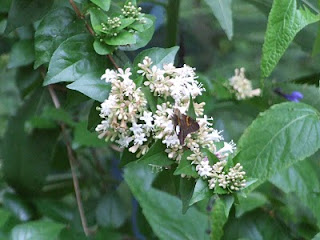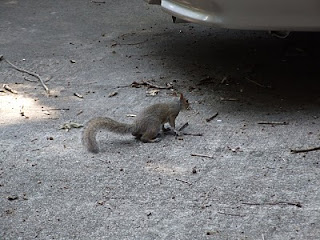Hot
The hottest day of the year. It was already 95 at lunchtime with a high of 103. I went outside to see what was happening.
It was hot. Really hot. The neighborhood was desserted. The air conditioners whirred near the houses. The chicadas screamed loudly in the shrubbery and occasionally there was a chirp from a cardinal. Even the mosquitos were lethargic.
The tiger swallowtail butterflies that had been nectaring on the Abelia chinensis were gone, but there was one small brown butterfly taking some nourishment.
I put fresh water in the birdbaths and turned on the dripper over the summersweet Clethra.
I walked to the side of the house where a pipevine swallowtail butterfly was laying her eggs on the Aristolochia, her wings beating wildly.
Small dark caterpillars were munching on the leaves. Soon there will be many more swallowtail butterflies.
The passionvine was enjoying the heat, splaying its wide purple flowers for fat fuzzy bees.
Squirrels hung out on the driveway, sifting through a pile of black oil sunflower seeds.
Startled, the squirrel ran away to join the clan hanging out near the fence.
The sunflower seeds failed to entice the chipmunks from their favorite spot in a pile of stones on the side of the driveway. Maybe it was cooler there.
Overhead some clouds were kicking up and a breeze started a soft rustling in the trees. Maybe the weather is changing.

























